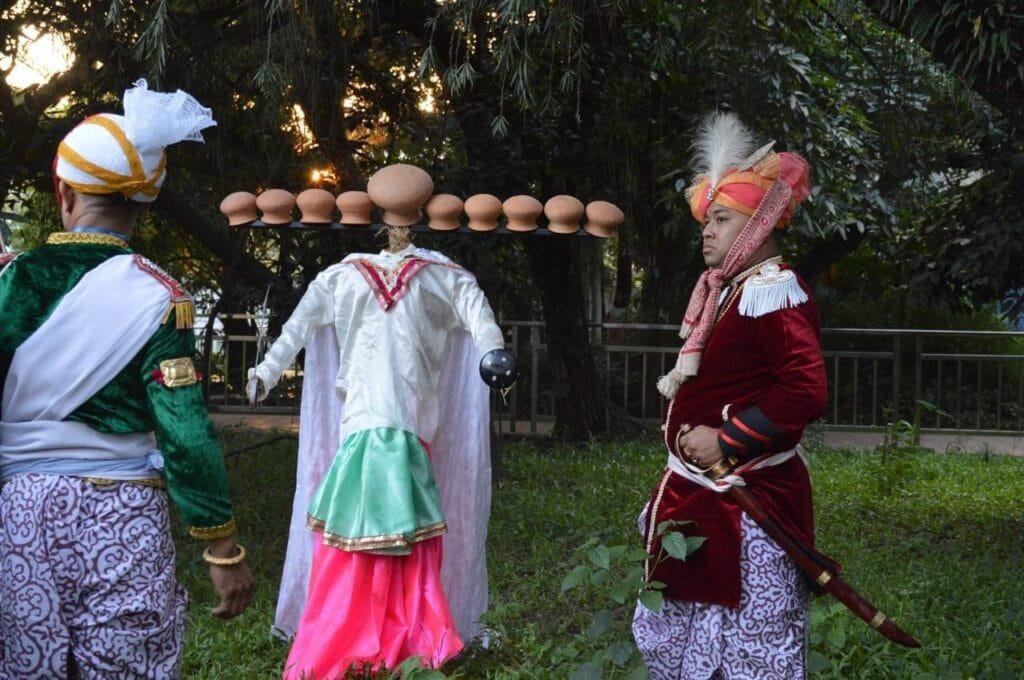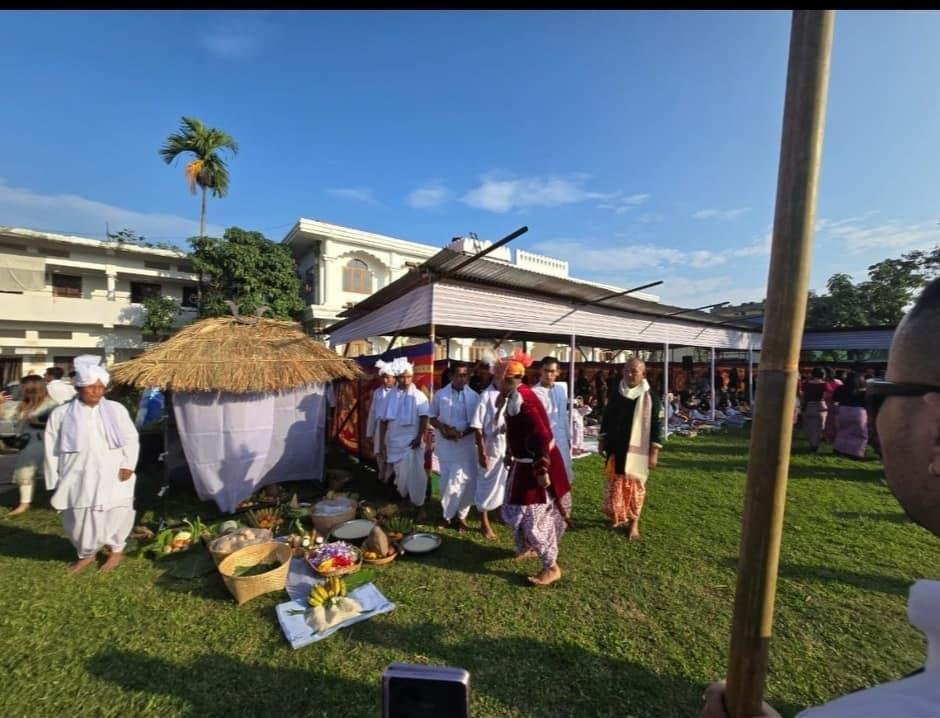Manipur, the land of mystic charms, is not short of festivals and celebrations. From the dawn of civilisation to modern times, the state has been observing several festivals, and keeping the flame of culture burning. One such festival takes center stage in the month of Mera, the 7th in the lunar calendar of Manipur.
As captured in the phrase ‘Mengna Lak ee Mera Tha’ (softly descends the radiant Mera month), this month signifies a tranquil beginning, and ushers in vibrant festivals and newfound prosperity. Major festivals celebrated during this month include ‘Mera Houchongba’, ‘Panthoibi Iratpa’, ‘Durga Puja’, ‘Kwaak Taanba’, ‘Mera WaaYungba’, ‘Hari Uthan’, and ‘Diwali’.
‘Kwaak Taanba’, translating to ‘Chasing of the Crows’, falls on the 10th day of Mera month. Despite being celebrated annually with great fanfare, the festival’s origins remain obscure. Today’s ‘Kwaak Taanba’ celebration represents a harmonious blend of Sanamahism and Hinduism, with roots tracing back to the pre-Hindu era of Meitei civilization’s formative years.
‘Kwaak Taanba’ during the Pre-Hindu period
There are numerous sources which serve as testimony to the festival’s pre-Hindu origins and provide insights on its origins, and the ways in which the festival was celebrated prior to the advent of Hinduism in the state. One such work is ‘Khunung Lichat Saajat’, according to which ‘Kwaak Taanba’ is annually celebrated on the 10th day of Mera month at Kangla. The source further states the ceremony is performed after praying to three Gods: Lai Nongshaba, Ibudhou Pakhangba, and Yumjao Lairembi. It is also worth mentioning that after King Garibniwaz (Pamheiba) adopted Hinduism as the state religion in the early 18th century, this ancient ceremony was re-named ‘Kwaak Taanba’ and Hindu elements were added, resulting in a seamless blend of syncretism between the two faiths.

Saroj Nalini Arambam Parratt’s ‘The Religion of Manipur’ (1980) also mentions Kwaak Taanba in a brief yet informative paragraph. According to Parratt, Kwaak Taanba was originally celebrated in commemoration of an event in which Pakhangba’s son Khui’s spirit entered the rare Wakambong bird. Khui had rebelled against his father and briefly seized the throne before Pakhangba defeated him in single combat and decapitated him, after which the event followed.
Ukai Kaappa
During the Fairel month of the traditional Meitei calendar, the ancient Meiteis conducted a ceremony known as ‘Ukai Kaappa’. In this ceremony, the Meitei king would shoot an arrow at a human effigy made of wood or bamboo. The section of the effigy struck by the arrow was subsequently used to predict the kingdom’s fortune. The relevance of this ceremony will be discussed in the subsequent section.
Contemporary Kwaak Taanba Ceremony
Although Hinduism arrived in Manipur as early as the 15th century CE, Garibniwaz’s accession to the throne in 1709 CE solidified its foothold. Between 1726-27, Garibniwaz replaced the rare Wakambong with the common crow, renaming the festival ‘Kwaak Taanba’. During his rule, the Kwaak Taanba ceremony took its present form, where flight directions replaced crow killings as omens: ‘northerly directions are generally propitious, while southerly directions portend evil’ (Parratt, 1980:44). Additionally, the ancient Ukai Kaappa ceremony became associated with Lord Rama’s defeat of Ravana, with the places struck by arrows being read as omens.
Rituals of Kwaak Taanba:
The festival can be divided into two parts: the morning session and the afternoon session. In the morning session, the phamnaibas (officials), accompanied by the LaanChing Purel (royal army commander), visit the Sana Konung to pay their respects to the Meitei King and seek his blessings. The afternoon session commences at around 1 pm, where the Meitei King, joined by the Angom King, officials, and the army commander, proceeds in procession to the designated venue – this year’s location being the WAL Club’s community hall at Wangkhei.

The procession features amaibis, pena khongbas, and a diverse group of women, including both married and unmarried individuals, walking side-by-side towards the venue. Following prayers for the festival’s smooth conduct, the LaanChing Purel chases away the crows. To do this, the crows are lured to a specific spot with food and then startled by gunfire from the LaanChing Purel. The direction of the crows’ flight is interpreted to determine the state’s fortune. The Kwaak Taanba festival also features various cultural dances, including the ‘maibi jagoi’ performed by amaibis (female priestesses), ‘thang ta’, and other cultural programmes.
In the days of the monarchy, Kwaak Taanba was more than just a simple religious festival. William McCulloch, the state’s political agent from 1844 to 1867, stated ‘At it (kwaak taanba) the tributaries lay presents before the Raja and renew their engagements of submission’. This underscores the festival’s significance beyond the religious realm. Even today, the Meitei King honors individuals with gifts of clothing in recognition of their services
A Shared Celebration: Kwaak Taanba and Dussehra
Garibniwaz’s incorporation of Hindu elements led to the festival becoming synonymous with the Hindu’s Dussehra festival. This similarity stems from the ‘Ukai Kaappa’ ritual paralleling the legend of Ram and Lakshman’s victory over Ravana. Both Ukai Kaappa and Dussehra feature effigy destruction, symbolizing good’s triumph over evil. This cultural convergence enabled syncretism, resulting in a distinct syncretic celebration. Additionally, Kwaak Taanba coincides with the final day of Durga Puja, mirroring Dussehra’s timing.
Conclusion
Every year, Meiteis eagerly await Kwaak Taanba, purchasing gold items on this auspicious day, believing it brings luck and goodwill. As a festival bridging Sanamahism and Hinduism, Kwaak Taanba seeks divine blessings for peace and prosperity in the state. Amidst today’s fast-paced world, where work cycles can be overwhelming, festivals like Kwaak Taanba offer a chance to rejoice and celebrate Manipur’s rich cultural heritage.
On this day, amaibis (priestesses) accompanying the Meitei King from Sana Konung (Royal Palace) to the venue worship Govinda and Rasheshwari at Shree Shree Govindajee Temple, Manipur’s largest Vaishnavite temple. This poignant display showcases harmonious coexistence and mutual respect among faiths in the state. As we explore Kwaak Taanba’s origins and influences, it’s essential to recognize, respect, and uphold this syncretic blend of traditions, preserving this centuries-old festival.
Reference
- Religion of Manipur (1980): A book by Saroj Nalini Arambam Parratt
- The Meitheis (1908): A book by T C Hodson
Working towards the Magnanimous Society.


